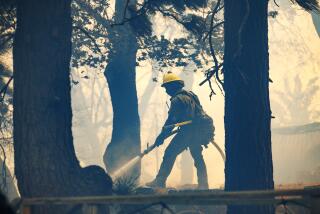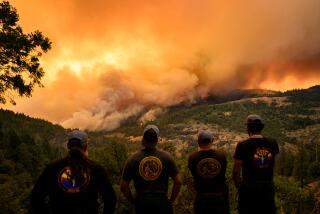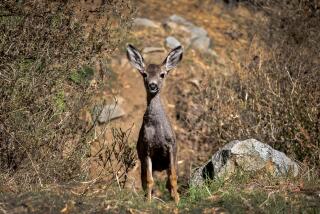THE OUTDOORS : Danger to the Deer : Fire That Destroyed Cover for the Sherwin Herd Also Creates Possibility of a Slaughter If There Is an Early Migration
MAMMOTH LAKES â Late each autumn, a chill settles on the summer range of the Sherwin herd high in the Sierra, and snow flurries tell the deer itâs time to start down the slopes to their winter home in the Owens Valley.
That usually occurs in late October or early November, but if it were to happen earlier--say, during hunting season in that zone, Sept. 10 to Oct. 2--the result could be a slaughter.
A fire last summer in the Laurel Creek area south of Mammoth Lakes destroyed the sagebrush and other growth along a narrow corridor of the migration route as it approaches U.S. 395. It also killed a thick growth of aspen along Laurel Creek at the base of the mountains and, in some places, burned all the way to the crest.
Without that cover during an early migration, the parading deer would fill the gun sights of hunters, who would hardly have to step out of their pickup trucks.
âIt would be like a shooting gallery,â said Lou Roeser, owner of the Mammoth Lakes Pack Outfit.
With four-wheel drive roads crisscrossing the area, Roeser visualizes a murderous cross fire and deer having to run the gantlet. âYou could wipe out the whole herd,â he said. âWe could have zero bucks.â
The Sherwin herd already is in trouble. The cover destroyed by the fire also provided food and fawning areas.
Deer, driven by their biological clocks and automatic homing systems, drop their guard during migration and become disoriented when confronted with man-made obstacles such as towns, roads, pipelines and power stations, all of which can be found in the Mammoth area and add to the stress of the migrating animals.
Roeser said he has seen deer so driven by instinct that they have tried to swim across man-made Crowley Lake in its formative years.
âThey get pretty punchy, to where they arenât aware,â Roeser said.
Ron Thomas, Mono County game manager for the stateâs Department of Fish and Game, conceded: âWhen those deer begin to migrate, they are much more vulnerable. Theyâve just come out of (the high country), and thereâs no place else for them to go. Theyâve been pushed out of the best places.â
Back in the 1950s when Mammoth Lakes was just a sprouting village, the deer followed Mammoth Creek through the town, their migrating instincts overriding their fears of the few inhabitants.
âAll our vehicles had dents in the fenders,â recalled Roeser, referring to incidents involving disoriented deer.
But later, as the town and traffic grew, the deer started to veer south into the open country around Laurel Creek, funneled between the town and the steep escarpments in a relatively narrow corridor.
âAnd every (local) hunter knows this,â Roeser said. âThey just wait for an early storm to drive the deer down.â
When that has happened, the shooting has been too close to town for comfort. Once, a spent bullet went through a school window and struck a teacher on the arm, according to Roeser.
Thomas, however, doesnât think an early migration is likely. He said: âI donât want to sell Lou short. That fire is a problem. But it would take an exceptionally early storm to get those bucks out on that open ground.â
Roeser: âBut itâs happened twice in the last nine years, and (each time) the buck herd has been slaughtered.â
Because of their concerns, Roeser and the High Sierra Packersâ Assn. have approached the DFG about closing the deer hunt in the X9B zone that runs from Mammoth down to Tomâs Place near the 7,000-foot Sherwin Summit, where the deer pass on their way to Round Valley.
Vern Bleich, associate wildlife biologist of the departmentâs Bishop office, said: âI told (Roeser) that we were not prepared to do anything like that. I canât predict the weather, but I donât anticipate that there will be a storm that early. With or without cover, with an early storm there would be a slaughter either way, and that would be a giant setback for the buck ratio.â
The season already is among the earliest in the state--âas early as is practical,â Thomas said.
The DFG has allotted 2,500 hunting tags to the zone, which includes other herds besides the Sherwin. Thomasâ figures show the Sherwin herd to have a population of only 2,810 deer, including about 10% bucks, a ratio he considers âterribly low.â
Rick Rockel, owner of Kenâs Sporting Goods in Bridgeport and president of the Mono Wildlife Council, said, âTheir quota is totally unrealistic.â
Rockel, however, said that Roeser and the packers are unduly alarmed.
âThereâs not going to be any impact during this hunt,â Rockel said. âThere wonât be any shooting in there at that time. Theyâve moved the deer season forward far enough to prevent any problem with the deer migration.â
Roeser wonât rest on such assurances. A resident of the area since its post-World War II boom, he also runs Old West Film Outfitters, which provides stock, equipment and often the actors--including himself--for TV commercials. He lists some celebrities among his clientele on various pack trips. An autographed photo of Joan Collins adorns one wall. But he has a special concern for the Sherwin herd, which he said was once one of the best.
âThere was no healthier herd,â Roeser said, citing a former âidealâ buck count of about 33%.
According to Thomas, the herd numbered 5,978 in the census of January, 1985, slipped a bit to 5,247 in â86 and then plummeted to 3,776 in â87.
âBut this is the scary part,â Thomas said. âThe fawn count had gone from 34 per 100 to 12. Thatâs not enough to maintain the population. Only half are going to be bucks, and most of the others wonât survive.â
Never mind humans and their guns.
âThe take by hunting is insignificant, 4% of the population,â Thomas said. âWe lost 23% of our radio-sampled deer to mountain lions in the last two years.â
A mountain lion, Thomas said, will kill an average of a deer a week.
But of even greater concern to Thomas is the shrinking winter habitat in Round Valley, where as many as 1,000 deer have been seen grazing in the alfalfa fields at one time. Some of the farmers, feeling no obligation to provide a free lunch, are talking of switching to other crops less palatable to deer.
Without that food, the pregnant does heading back up the mountains in the spring âhave got a long hike,â Thomas said.
âTheyâre carrying one or maybe two babies, so they need food for three bodies. Then start adding all these dwellings and domestic dogs chasing them. Everything close to their migration route adds to the stress. Itâs a damn miracle there are any deer.â
And yet, Thomas added: âI hate to see a total closure (of the hunting season). That drastic step couldnât hurt the deer, but if thereâs a biological resource that would support some harvest, you should allow it. Iâd lean toward habitat improvement, instead.â
Thomas said the DFG is hoping to buy or lease land for alfalfa fields in the valley.
Roeser said: âWhether they close it down completely may not matter--just if it storms, thatâs OK. They donât even have to shut off all
of X9B, just the migration route.â
Roeser admitted that he and the other packers are open to charges of self-interest because of their position.
âThe people in town say, âWell, the packers want to keep (the deer) up where only they can get to âem,â â he said--meaning they would gain more business from packing in hunters to the back country.
But that, Roeser said, is where deer should be hunted, not on their way down the mountain where no hunting skills are required other than the patience to sit and wait for them to walk by.
âAny hunter who has to hit âem in a stress migration situation shouldnât be given a hunting license,â Roeser said. âDeer should be hunted in a sporting situation, where they have a chance.â
More to Read
Sign up for The Wild
Weâll help you find the best places to hike, bike and run, as well as the perfect silent spots for meditation and yoga.
You may occasionally receive promotional content from the Los Angeles Times.






